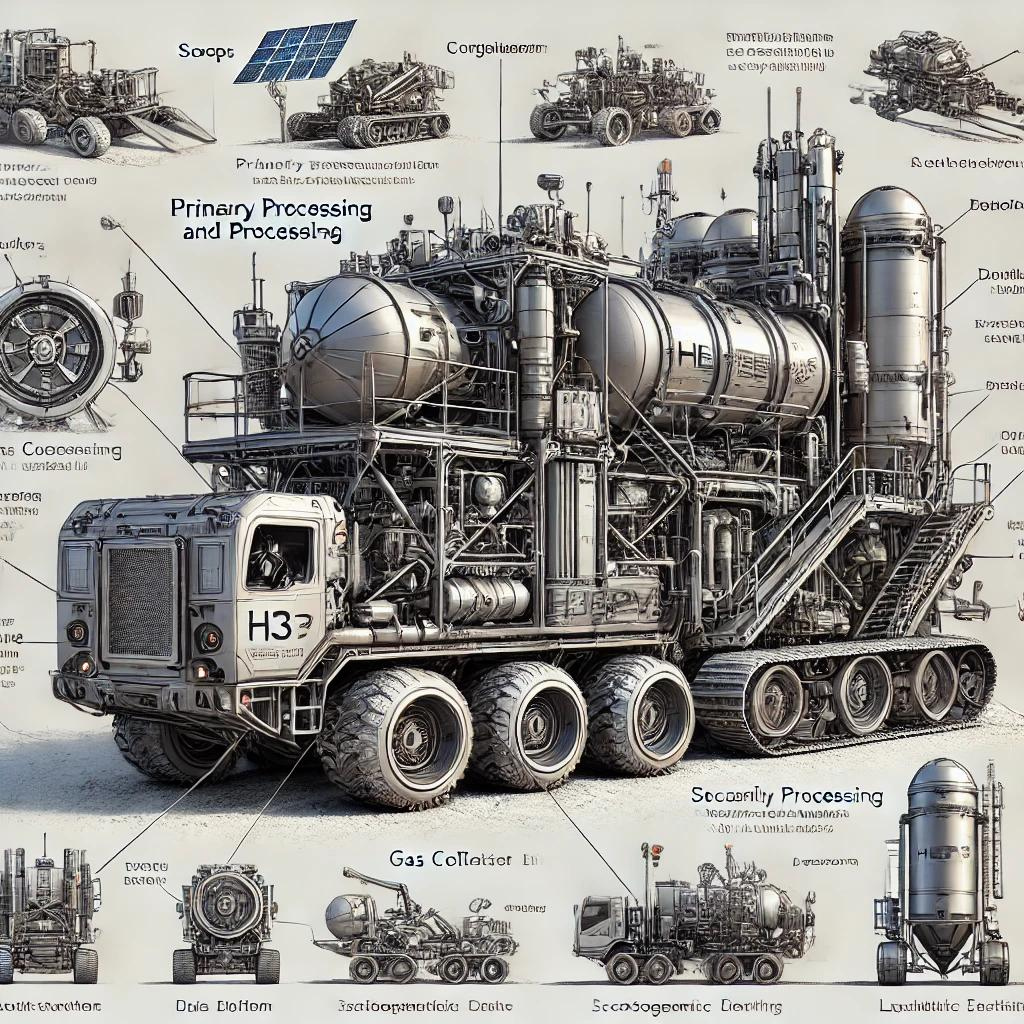Helium-3 Extraction and Processing Vehicle (H3EPV)
The Helium-3 Extraction and Processing Vehicle (H3EPV) is an advanced, AI-powered autonomous vehicle designed specifically for the extraction, processing, and storage of helium-3 from lunar regolith. This vehicle is engineered to operate efficiently in the harsh lunar environment, leveraging cutting-edge technology to achieve its mission. Below is a detailed description of its components and functionalities:

Exterior Design
The H3EPV features a robust and compact design tailored to navigate the rugged terrain of the Moon. Its exterior is constructed from lightweight, radiation-resistant materials to ensure durability and protection against the extreme temperatures and radiation levels found on the lunar surface. The vehicle is equipped with advanced mobility systems, including all-terrain wheels and suspension systems, allowing it to traverse craters, rocks, and slopes with ease.
Key Components
- Regolith Collection System
- Scoops and Drills: The front of the vehicle is fitted with a combination of scoops and drills designed to excavate lunar regolith efficiently. These tools are capable of penetrating various soil types and depths to access helium-3-rich layers.
- Conveyor System: Once the regolith is excavated, it is transported via a conveyor system to the primary processing chamber.
- Primary Processing Chamber
- Heating Mechanism: Inside the primary processing chamber, the collected regolith is subjected to high temperatures (600-700 degrees Celsius) using a sophisticated heating mechanism. This process releases helium-3 gas along with other volatiles trapped in the soil.
- Gas Collection Unit: The released gases are captured by a gas collection unit equipped with filters to separate helium-3 from other gases.
- Secondary Processing Chamber
- Cryogenic Cooling System: The helium-3 gas is transferred to the secondary processing chamber, where it undergoes cryogenic cooling. This chamber is equipped with advanced refrigeration units that cool the gas to -269 degrees Celsius, liquefying the helium-3 for easier storage and transport.
- Gas Transfer Mechanism: The cooling system includes a transfer mechanism that ensures the gas is efficiently moved between stages of processing without significant loss or contamination.
- Storage Tanks
- Liquid Helium-3 Storage: The vehicle is equipped with specially designed storage tanks that can maintain the extremely low temperatures required to keep helium-3 in its liquid state. These tanks are made from high-strength, thermal-resistant materials and are insulated to prevent heat transfer from the external environment.
- Capacity and Safety Features: Each storage tank is equipped with pressure sensors and safety valves to monitor and regulate the storage conditions, ensuring the integrity and safety of the stored helium-3.
- Power and Control Systems
- Solar Panels: The H3EPV is powered by high-efficiency solar panels that generate electricity from the Sun. These panels are mounted on top of the vehicle and can be adjusted to maximize solar exposure.
- Battery Storage: The vehicle is equipped with advanced battery systems that store excess energy generated by the solar panels, providing power during lunar nights or in shadowed areas.
- AI and Autonomous Navigation: The H3EPV is controlled by an advanced AI system capable of autonomous operation. The AI handles navigation, obstacle avoidance, task scheduling, and real-time decision-making. It is equipped with various sensors, including lidar, cameras, and spectrometers, to gather environmental data and optimize operations.
Operational Workflow
- Site Selection and Navigation: The AI system identifies and navigates to helium-3-rich areas using pre-mission data and real-time analysis.
- Regolith Extraction: The vehicle uses its scoops and drills to collect regolith, which is transported to the primary processing chamber.
- Heating and Gas Collection: The regolith is heated to release helium-3 gas, which is then collected and filtered.
- Cooling and Liquefaction: The helium-3 gas is transferred to the secondary processing chamber, where it is cooled and liquefied.
- Storage: The liquefied helium-3 is stored in specialized tanks, ensuring safe and efficient containment.
- Monitoring and Reporting: The AI system continuously monitors the vehicle’s systems and storage conditions, reporting data back to a central control station on Earth.
Advantages and Applications
The H3EPV is designed to operate autonomously for extended periods, minimizing the need for human intervention and reducing operational costs. Its ability to extract, process, and store helium-3 on-site makes it a critical component of lunar mining missions, providing a sustainable and efficient method for harnessing this valuable resource.
The vehicle’s modular design allows for scalability and adaptability, enabling it to be used in various lunar environments and for different mining operations. Its advanced AI capabilities ensure high efficiency and safety, making the H3EPV a pioneering solution for the future of space mining.